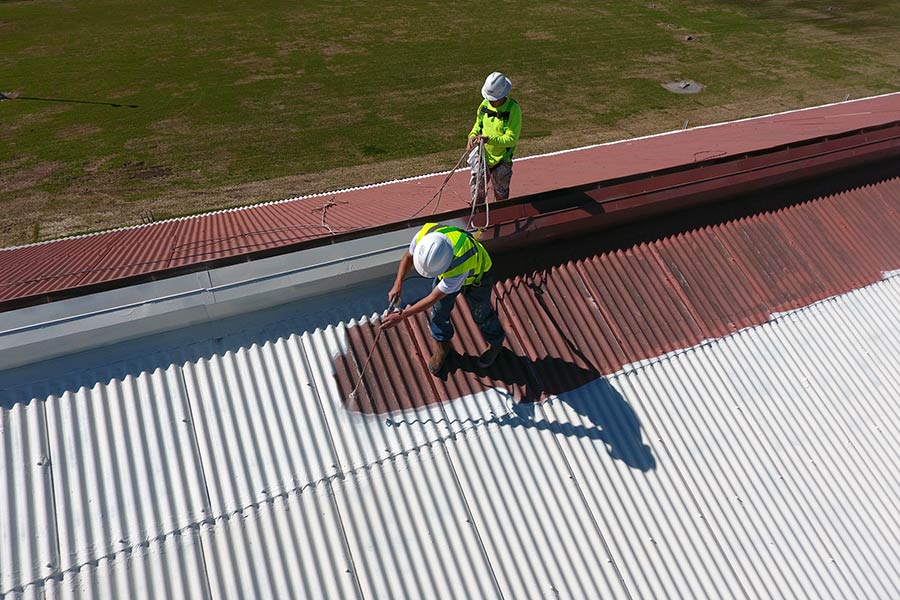
Working with roof coatings during the winter season can be tough. Below, we provide some valuable insights to help our Approved Contractors stay productive, minimize downtime, and ensure system performance.
What Are the Best Cold Weather Roof Coatings?
The chemistry of each roof coating reacts differently in cold temperatures—this is especially true for water-based coatings such as acrylics. Acrylic products are likely to improperly dry or even freeze if temperatures drop low enough the night following their installation. Wash-offs are also a common occurrence in the winter due to slow drying or rain-related problems. Water-based coatings should only be installed at 50°F and rising to avoid all of these types of issues.
While solvent-based coatings will not face the same problems as water-based coatings, they also come with their own challenges. When stored in colder temperatures, urethane and silicone roof coatings both thicken to the point that they can’t be sprayed or rolled properly. The temperatures of the air and roof surface are not nearly as important as the temperature of the coating. Solvent-based coatings will successfully spray or roll when stored at 70°F, even on a roof with a surface temperature of 35°F–40°F.
It is not recommended to install any roof coatings, whether water-based or solvent-based, in below-freezing temperatures as precipitation on the roof will not be as evident.
Below, we cover cold weather applications for each of the roof coatings that make up our core systems.
Acrylics
Our Met-A-Gard and Met-A-Gard+ roof coating systems are comprised of acrylic coatings such as Acrylic 211, High-Tensile Acrylic 211, Acrylic Butter-Grade 221, and Red Oxide Rust Prime 912. As stated earlier, these water-based acrylics are prone to improper drying or freezing if left in low temperatures for an extended period of time. They can no longer be used once frozen, even after thawing.
Temperature should also be taken into account for storage of roof coatings. If the warehouse in which the products are temporarily stored gets cooler than 30°F, the coatings should be moved to a heated area. During application, installers should ensure that the temperature is 50°F and rising to prevent slowing of acrylic dry time.
It should be noted that acrylic coatings are also affected by warmer temperatures. Dew and humidity can impact the dry time of acrylic coatings as well.
Silicones & Urethanes
The Ure-A-Sil System is comprised of silicone and urethane coatings such as Aromatic Urethane 520, Urethane Brush-Grade 522, Silicone 410, and High-Solids Silicone 412. Both urethanes and silicones are solvent-based coatings, so they can handle colder temperatures during the drying process.
As stated earlier, however, they are prone to thickening inside the pail if not stored properly. Urethane and silicone roof coatings should be stored in temperatures of at least 70°F. If the coatings are being stored on a job site, they should be kept in an enclosed trailer with portable heat. If the coatings are being stored on a rooftop, they should be covered with a black tarp—the dark color will help absorb the sun’s heat. The tarp will also keep moisture off of the pails. Pail warmers are also of use in this situation.
Silicone roof coatings that have become too thick can be thinned using 100% pure mineral spirits or xylene, so long as the thinning process does not exceed 5% of the solvent and a thorough mixture has been ensured.
The only exception is Urethane Brush-Grade 522. As a mastic, it is designed to be thick. If the product becomes too thick to use, it may not be possible to thin. As such, it is best to store Urethane Brush-Grade 522 in an enclosed, warm area.
For more helpful insights on working with cold weather roof coatings, check out our post on preparing your hydraulic spray equipment for winter. For technical questions, click here to contact our Technical Services department or call (800) 309-6416.
Related Posts
The Pros and Cons of Acrylic Roof Coatings
Often referred to as the “original” elastomeric coating, acrylic roof coatings are generally a popular choice for sloped metal roofs. However,…
Negatives of Acrylic Coatings on Flat Roofs
Acrylic roof coatings provide many benefits. Not only are they more cost-effective than other coating chemistries, but they’re also highly…
Urethane vs Silicone Roof Coatings Adhesion Test
In this edition of Tech Talk, Brian and Eric perform an adhesion test on our roof coating products Silicone 410 and Aromatic Urethane 520. As…


